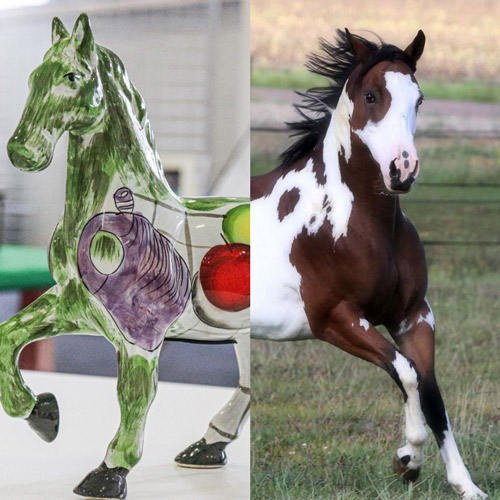
We imagine the piebald horse a bit like this piece of our collection. Our most ... "controversial" work of art.
A very kitch horse, which instead of an elegant size has a tablecloth laden with fruit and vegetables. Actually we know that this type of coat can be of various types and colours, like the brown and white one in the photo that gallops freely in a beautiful meadow.
The horse's coat differs both in colour and in some characteristics such as spots, marks or shades. The colouring of the horse's coat comes from genetic factors and the classification of the horse's coat can vary based on several factors.
In addition to the classification of the colour, the shades and variations of hue are also included. The coat is diversified into simple, compound coats, coats with two or three colours that give the particularity resulting from the mixture of hair and horsehair giving gradations of shades. Among these, the pomellato is typical of horses with dark gray hairs that form rings on a gray background.
The so-called piebald coats are instead formed by two or more colours, gathered to form patches of different colours distributed on the body. If white prevails over black, we speak of black pied, if instead black prevails we speak of white pied.
Whether it's our imagination or real, the piebald horse remains a symbol of nprecedented charm and beauty!
A very kitch horse, which instead of an elegant size has a tablecloth laden with fruit and vegetables. Actually we know that this type of coat can be of various types and colours, like the brown and white one in the photo that gallops freely in a beautiful meadow.
The horse's coat differs both in colour and in some characteristics such as spots, marks or shades. The colouring of the horse's coat comes from genetic factors and the classification of the horse's coat can vary based on several factors.
In addition to the classification of the colour, the shades and variations of hue are also included. The coat is diversified into simple, compound coats, coats with two or three colours that give the particularity resulting from the mixture of hair and horsehair giving gradations of shades. Among these, the pomellato is typical of horses with dark gray hairs that form rings on a gray background.
The so-called piebald coats are instead formed by two or more colours, gathered to form patches of different colours distributed on the body. If white prevails over black, we speak of black pied, if instead black prevails we speak of white pied.
Whether it's our imagination or real, the piebald horse remains a symbol of nprecedented charm and beauty!
 English (United Kingdom)
English (United Kingdom)





